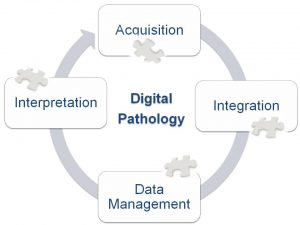Empowering Patients With Digital Pathology
 This post originally appeared last October. The intent was to write it for patients in a way that would briefly define pathology to the lay public and explain how digital pathology could empower them in their own care. The post was print syndicated to patient advocacy and health/wellness sites. Since and before the post, it has become more apparent to me that while we talk about the technology empowering pathologists to make accurate diagnoses with less turn around time, a real value proposition may be empowering patients.
This post originally appeared last October. The intent was to write it for patients in a way that would briefly define pathology to the lay public and explain how digital pathology could empower them in their own care. The post was print syndicated to patient advocacy and health/wellness sites. Since and before the post, it has become more apparent to me that while we talk about the technology empowering pathologists to make accurate diagnoses with less turn around time, a real value proposition may be empowering patients.
With the increasing use of electronic health records and a requirement to meet meaningful use criteria, hospitals and laboratories are going to be required to provide patients with an electronic copy of their health information (including diagnostic test results, problem list, medication lists, medication allergies, etc…), upon request. Patients will expect and anticipate their digital slides much in the same way they anticipate their radiology images, laboratory reports and medication lists to have as they seek medical attention from outside that particular hospital network. While there are some requirements for EHRs to have a degree of interoperability and this has been accomplished to date, it seems unlikely this will happen outside of a few recognized large-scale health organizations working cooperatively within their own markets. Thus, access to digital slides will be a consumer (patient) -driven market where the patient can have a portable format for their pathology slides, offering several advantages over analog slides as is commonly performed. This of course will require additional resources to create and provide secure access to patient slides, however, original slides can be retained, multiple reviews of digital slides can occur simultaneously, second reviews and tumor board reviews can occur in near real-time across institutions and we can all better serve our patients. And isn’t that our shared goal?
Patients rely on pathologists as a life saving resource when it comes to diagnosing ailments from cancer to stomach bugs. While pathologists play an integral role in the healthcare system, pathology itself is often slow and not always completely accurate, which can directly impact patient care. However, as technology advances, new tools like digital pathology empower patients in the diagnosis and treatment of their bodies, bringing pathology from an analog science to a digital one.
Digital pathology is the practice of digitizing patient sample slides, transferring them from the microscope to the computer. Sample slides are scanned using special equipment that produces high definition images that are then viewed on computers or mobile devices throughout a hospital or medical practice. The high quality of the digital slide images produced allow pathologists to zoom in, similar to a microscope, to see the sample at the cellular level.
Better Diagnosis
While the human eye of a pathologist can recognize abnormalities in tissue samples, it often takes hours of examining multiple patient slides to come to a conclusion and diagnosis. With the help of computer software, digital pathology equipment can analyze patient slides in a more systematic way, allowing pathologists to not only see abnormalities, but quantify them. For example, digital pathology can help a pathologist find cancer cells in a patient slide, but then takes the results further by actually counting the abnormal cells present. Pathologists can then leverage the large sets of data contained in the slides to not only provide a diagnosis, but also to better target treatment options.
Timely Results
Digital pathology uses computer technology to quickly analyze multiple slides at once, creating a greater picture of a patient’s sample in significantly less time. This technology is also used to quickly draw a pathologist’s attention to hot spots in the sample, decreasing the amount of time it takes the doctor to make a diagnosis. These benefits accelerate patient care, as well as is life saving in medical cases where time impacts the patient’s outcome.
Training for the Future
With digitized slides stored for each case, this information is easily accessible for review and learning purposes for students in medical school or in their residencies. Instead of having access only to on site available slides, medical students can view pathology slides from anywhere in the world through the internet. The availability of data eventually benefits patients by having a workforce of doctors who can better diagnose and treat their patients. Slide data can also be used to help develop new technologies and treatments for diseases, increasing the outlook for patients in the future.
Though digital pathology is still a growing field, aversion to the technology by pathologists is lessening as digital tools that are easier to learn and use are introduced to the market. The introduction of products like iPads and other tablet devices also increases the use of digital pathology as doctors more easily access patient information quickly from anywhere, increasing the benefits to both doctors and patients.

































